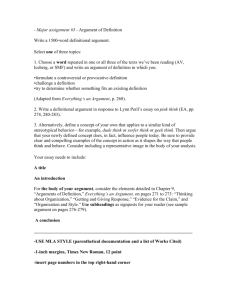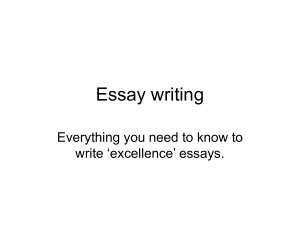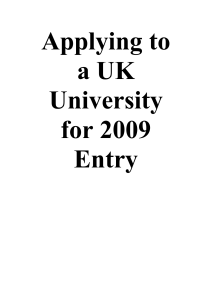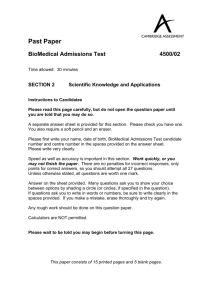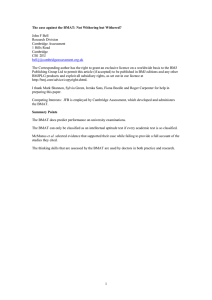HOW TO MASTER THE CAMBRIDGE ADMISSION TESTS? The
advertisement
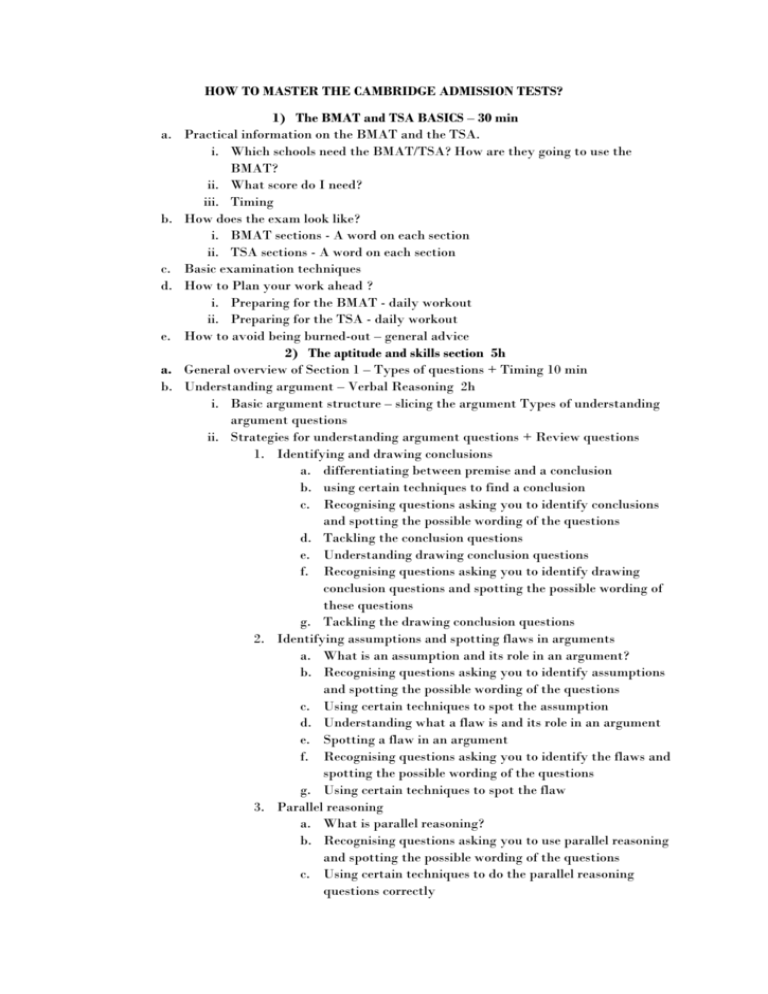
HOW TO MASTER THE CAMBRIDGE ADMISSION TESTS? a. b. c. d. e. a. b. 1) The BMAT and TSA BASICS – 30 min Practical information on the BMAT and the TSA. i. Which schools need the BMAT/TSA? How are they going to use the BMAT? ii. What score do I need? iii. Timing How does the exam look like? i. BMAT sections - A word on each section ii. TSA sections - A word on each section Basic examination techniques How to Plan your work ahead ? i. Preparing for the BMAT - daily workout ii. Preparing for the TSA - daily workout How to avoid being burned-out – general advice 2) The aptitude and skills section 5h General overview of Section 1 – Types of questions + Timing 10 min Understanding argument – Verbal Reasoning 2h i. Basic argument structure – slicing the argument Types of understanding argument questions ii. Strategies for understanding argument questions + Review questions 1. Identifying and drawing conclusions a. differentiating between premise and a conclusion b. using certain techniques to find a conclusion c. Recognising questions asking you to identify conclusions and spotting the possible wording of the questions d. Tackling the conclusion questions e. Understanding drawing conclusion questions f. Recognising questions asking you to identify drawing conclusion questions and spotting the possible wording of these questions g. Tackling the drawing conclusion questions 2. Identifying assumptions and spotting flaws in arguments a. What is an assumption and its role in an argument? b. Recognising questions asking you to identify assumptions and spotting the possible wording of the questions c. Using certain techniques to spot the assumption d. Understanding what a flaw is and its role in an argument e. Spotting a flaw in an argument f. Recognising questions asking you to identify the flaws and spotting the possible wording of the questions g. Using certain techniques to spot the flaw 3. Parallel reasoning a. What is parallel reasoning? b. Recognising questions asking you to use parallel reasoning and spotting the possible wording of the questions c. Using certain techniques to do the parallel reasoning questions correctly 4. Weakening and strengthening arguments a. What is meant by weakening and strengthening an argument? b. Recognising questions asking you to weaken/strengthen and argument and spotting the possible wording of the questions c. Using certain techniques to answer such questions correctly c. Problem Solving 2h i. The basic background knowledge – quick remainder ii. Question format and structure iii. The 6 Basic Principles of Problem Solving Questions iv. Types of questions and strategies for understanding argument questions + Review questions 1. Complex calculations – examples + skills involved (recognise; understand; manipulate; proof) a. Clocking times and dates b. Speeds, distances and times c. Pounding money d. Smashing fractions e. Probability f. Pummeling percentages g. Sorting spatial measurements 2. Equation questions a. Identify the unknown quantity, Setting up the equation, Solving the equation, checking your answer, trial and error method 3. Visual reasoning a. Create a visual interpretation, manipulate your visual interpretation and use four visual interpretation to answer the question 4. Spatial awareness a. Understand what the question requires and apply the correct process to visualize the result 5. Lateral thinking a. Understand the question, decipher the result, apply the process step by step d. Data Analysis and Inference – Statistical and Graphical + Review questions 50 min i. Extracting and interpreting data ii. Question format and structure iii. Elements of a graph and a table (heading, descriptions, labels) iv. Types of graphs - a brief overview v. Inference vi. Maths vii. Graphical interpretation and understanding viii. The 3 Basic Principles of Data Analysis and Inference ix. Strategies – Step by step e. Data and statistics – a quick remainder + Review Questions 30 min i. Measures of central tendency ii. Statistical Graphs iii. Scatter Plots iv. Stem and Leaf Plots v. Histograms vi. Probability vii. The Counting Principle 3) Aptitude and skills test – Step by step – How to implement the examination techniques? 2h a. Use the format each time. b. Checking answers and explaining every 10 questions – there are 40 questions. 4) The BMAT Essay 2h a. General concepts i. How does the essay look like? ii. Timing + structure – step by step method to write an essay iii. How is it graded? iv. Is it important? – The significance of the BMAT essay in terms of your interview. v. General advice - dos and don’ts! b. Format i. What makes a good introduction? – Introduction components ii. Argument structure 1. How to structure an argument? 2. What makes a good example? c. Types of essays – a word on each type + sources + examples of topics and sample works i. Scientific ii. Medical iii. Philosophical iv. Veterinary topics 5) BMAT Essay checklist and discussion –overview of the components 40 min TOTAL TIME REQUIRED: approximately 11h SUGGESTED: 3 sessions o o o o o o DAY 1 The BMAT and TSA BASICS – 30 min The aptitude and skills section (General overview +Problem Solving + Verbal Reasoning) – 4h 10 min TOTAL: 4h 40 min DAY 2 The aptitude and skills section (Data Analysis and Inference + Data and Statistics) – 1h 20 min Aptitude and skills test – Step by step – How to implement the examination techniques? 2h TOTAL: 3h 20 min DAY 3 o o o The BMAT Essay 2h The BMAT Essay Practice – Discussion 40 min TOTAL 2h 40 min

